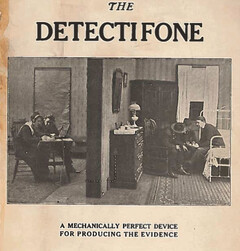
Eavesdropping
The University of Melbourne
Swanston Street
Parkville Victoria, VIC
URL: eavesdropping.exposed
EAVESDROPPING used to be a crime. According to William Blackstone, in his Commentaries on the Laws of England (1769): ‘eavesdroppers, or such as listen under walls or windows, or the eaves of a house, to hearken after discourse, and thereupon to frame slanderous and mischievous tales, are a common nuisance and presentable at the court-leet.’ Two hundred and fifty years later, eavesdropping isn’t just legal, it’s ubiquitous. What was once a minor public order offence has become one of the most important politico-legal problems of our time, as the Snowden revelations made abundantly clear. Eavesdropping: the ever-increasing access to, capture and control of our sonic worlds by state and corporate interests.
But eavesdropping isn’t just about big data, surveillance and security. We all overhear. Listening itself is excessive. We cannot help but hear too much, more than we mean to. Eavesdropping, in this sense, is the condition – or the risk – of sociality per se, so that the question is not whether to eavesdrop, but the ethics and politics of doing so. This project pursues an expanded definition of eavesdropping therefore, one that includes contemporary mechanisms for listening-in but also activist practices of listening back, that is concerned with malicious listenings but also the responsibilities of the earwitness.
This project directs our attention towards specific technologies (audio-tape, radio-telescope, networked intelligence) and politics (surveillance, settler colonialism, detention). Some contributions address the personal and intimate, others are more distant or forensic. Their scale ranges from the microscopic to the cosmic, from the split-second to the interminable. What all the artists and thinkers involved have in common, however, is a concern not just for sound or listening, but what it might mean for someone or something to be listened-to.
EAVESDROPPING is a unique collaboration between Liquid Architecture, Melbourne Law School and the Ian Potter Museum of Art, comprising an exhibition, a public program, series of working groups and touring event which explores the politics of listening through work by leading artists, researchers, writers and activists from Australia and around the world.
EXHIBITING ARTISTS
Athanasius Kircher, Fayen d’Evie and Jen Bervin with Bryan Phillips and Andy Slater, Joel Spring, Lawrence Abu Hamdan, Manus Recording Project Collective; Michael Green, André Dao, Jon Tjhia, Abdul Aziz Muhamat, Farhad Bandesh, Behrouz Boochani, Samad Abdul, Shamindan Kanapathi and Kazem Kazemi, Samson Young, Sean Dockray, Susan Schuppli, William Blackstone
TALKS & PERFORMANCES
Andrew Brooks, Brian Hochman, Ceri Hann, Jake Goldenfein, Jasmine Guffond, Jennifer Stoever, M J Grant, Mark Andrejevic, Mehera San Roque, Peter Szendy, Poppy de Souza, Sam Kidel, Samson Young, Sara Ramshaw, Sean Dockray, Susan Schuppli, Tim McNamara
Acknowledgements
Exhibition Design: Sibling Architecture
Technical Design: Marco Cher-Gibard
Online/Offline: Public Office
CURATORS
Joel Stern (Liquid Architecture) and Dr James Parker (Melbourne Law School).
Artists












